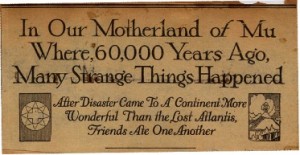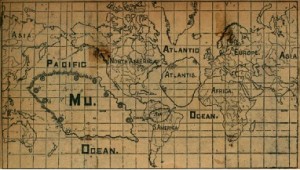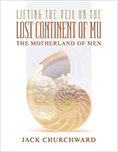Part 1 with the complete dedication is here.
Another article about Captain E.A Salisbury


In Our Motherland of Mu Where 60,000 Years Ago Many Strange Things Happened
After disaster came to a continent more wonderful than the lost Atlantis, Friends ate one another.
Captioned picture(s):
Captain Edward A. Salisbury, explorer and ethnologist, who has devoted twelve years to a study of the evidence indicating the existence of the great continent of Mu 50,000 years ago, in the center of what is now the Pacific Ocean. The map shows its probable extent and that of the more generally known “Lost Continent” of Atlantis of which the ancient Greeks had many traditions. The map also shows the location of the great interoceanic canal built by the Muans into a sea that is now the watershed of the Amazon River. The great upheaval that lifted the Andes Mountains lifted the canal and both its ends are far above sea level.
It is quite passé to talk about the Lost Atlantis. Its mythical fields have been beaten barren with the feet of poets, writers of imaginative fiction and a few scientists of the Oliver Lodge variety. So, for the second time, it is sunk and in its place rises a land, a little more substantial, known to us Uighurs as Mu, the Motherland of Man.
“Mu.” Doesn’t the word arouse some deep-seated brain cell in the subconscious to a faint hurrah of patriotism? It should. We Uighurs are Mu-ans for 60,000 years or so – one of the ten tribes, in fact – and we more atavistic ones should have an exclusive impulse, at a mention of her name, to bow to Ra-Mu, the emperor.
Where is Mu, our motherland, anyhow? Capt. Edward A. Salisbury, famous explorer and ethnologist, who is stopping by the Commonwealth hotel for several weeks, can explain it all. He is soon to depart for Burma to search the clay libraries for some more sidelights on its prehistoric culture.
Mu, the cradle of life, was a vast continent until 12,000 years ago, when her last segment gave the Pacific Ocean more floor space, lying roughly between the Hawaiian Islands and the Fiji Islands on the south, Japan on the west and the Easter Islands, off the coast of South America, on the east. The continent measured 5,000 miles east and west and 3,000 miles north and south.
The continent was a vast plain, most of it over gas strata, just as Texas and California are over gas belts today. Captain Salisbury begs, however, that Texans and Californians be not afraid, because it sometimes takes and aeon or two for the gas to become volcanic.
Seventy-five thousand years ago Mu was a highly civilized nation of 65 million inhabitants. Through its sloping plains ran seven great rivers. At the mouth of each stood a great city. So it was the land of seven rivers and seven cities, Captain Salisbury pauses.
“There we have, perhaps, the mystic seven of all religions,” he says.
“There, perhaps, the first 7-headed hydra was reared in a temple. Those hydras stand today as guardians of Cambodian gates.
An Advanced Civilization
The Mu-ans give us a heritage, if at all, to be proud of. One is perfectly justified in waving a flag in every atavistic dream pertaining to Mu. This plainland was more highly civilized than Atlantis. Its people had great mills. They wore silk and fine linen. Like the Egyptians, they tossed thunderbolts from their fingers tips. The circumlocutions of modern science were unknown. They treated illness by thought and vibration.
Such inane conversations as this could never have been conducted on the streets of any Mu-anese city:
“Well, how on earth are you? I haven’t seen you for ages. Where have you been keeping yourself?”
A Mu-an would have known. He had developed mental telepathy. Thought transference was an accomplishment of every ordinary educated citizen.
“Don’t be surprised at that,” said Captain Salisbury. There are still cannibal tribes in the South Seas who see you before you arrive and can tell you what you did at the last place. They have no telephones or runners, either. They are telepathic.”
From the continent of Mu colonists went out through the world. Colonization began about 75,000 years ago. There were ten tribes of Mu-ans – The Uighurs, from which we spring; the Tamils, the Negro tribe, and others. The Uighurs went westward, as Uighurs, if such we are, have been doing it ever since. They went into Europe, into England, and founded the basis of the tribes of which we learn from Caesar. The Cro-Magnon man, the Piltdown man, all of those interesting, baldheaded, grinning friends of the European museums of prehistoric life were the children of the Uighurs.
The Tamils, who lived in the south of Mu, jumped across the straits formed by their coast and the coast of South Africa; jumped over the Andes. In the center of South America was a vast inland sea. The Amazon is all that is left of this great Tamil resort.
A Canal Now High in Air
“And now,” said Captain Salisbury, squinting his blue eyes significantly and taking a deep drag from his cigar, “we understand that broad, mysterious ditch cut across the Andes, a ditch man-made, beginning in air, ending in air. Science for many years was baffled by it. That was a canal from the Pacific Ocean into the South American inland sea.”
It is erroneous, of course, to say that the Tamils dug that ditch in the Andes. There really were no Andes. They had not been lifted. A vast cataclysm did that later. Andes and the canal were elevated at the same time.
From South America the Tamils crossed into Africa, where they still may be found. Every one of the tribes of Mu sent out shoots. … the brown men, the yellow men, red men found their places in the world. The continent of Mu was overpopulated and Ra-Mu, the emperor, the Mussolini, commanded the nation to expand.
They were a simple-hearted, God-fearing people, these Muans. Their surviving literature – if indeed, it is theirs and not the writing of some Chinese Edgar Rice Burroughs – tells us they knew not war nor strife. They were at peace with themselves and with their faraway and only neighbors, the doomed inhabitants of Atlantis, mythical or not, as you please.
Down in Titanic Cataclysms
And, then, 15,000 years ago, the eastern half of Mu was shaken by great earthquakes. Tidal waves swept over the land. Volcanoes burst forth. The eastern half sank, leaving a few wretched Mu-ans lodged on the foothills of barren, fireswept, volcanic islands.
“They were without vegetation, fish, food of any kind,” the captain explained. “They were forced to eat the weaker members of the group. They lived upon these weaker ones until vegetation sprang up, until fish killed or driven away by the great upheavals, returned to those ocean waters. And so we have cannibalism. At first a necessity, it became a religious custom, a surviving justification, even after vegetation and fish returned.
“These cannibal tribes of the South Sea Islands carried this religious custom later through South America and into Africa. We find it on both continents. But it began with the destruction of the Eastern half of Mu.
“Three thousand years passed. The 30 million people left on the mainland readjusted their civilization. Many of them were insane with the disaster. Commerce was shattered. And just about the time the remainder of Mu was restored to calm, industry and sanity, a thunder shook the earth and the last of Mu sank into the Pacific. In the same cataclysm Atlantis perished. The mountains of the earth reared their heads and the surface of the earth took the general appearance we know.
Whence came this strange legend? Or, if a scientific fact, whence came the data? Captain Salisbury gives a rational explanation.
Fifty years ago James Churchward, an English ethnologist, then in military service, was sent to India to lend relief in a famine. He administered his merciful work from a Naacal temple, Naacal priests assisting. They were silent, peaceful men with a great capacity for gratitude. And when the work was done, the oldest priest removed from a vault two clay tablets and said to Churchward:
“These tablets are of Mu, the language of Mu, which we alone understand.
And the priest translated them. They were Mu-anese history. But they began unrelated and ended unrelated. One of them was broken. Churchward repaired it. This gave the priest confidence. At first reluctant to reveal all, he at length gave Churchward the use of all fifty. They described the continent of Mu, some of its history, its science, its colonizations. But they did not tell all. Those tablets, Churchward explained in a privately circulated volume, are more than 50,000 years old.
More From Yucatan Tablets
Churchward thenceforward gave his life to the search for data pertaining to Mu. Captain Salisbury said Churchward was the only living man who knew the language of Mu but would not, for some unstated reason, permit the disclosure of the alphabet until his death.
From legends, ideagraphs, and customs of South Sea Islands and Mexico, Churchward learned much. Captain Salisbury has given twelve years of exploration to the service of Churchward already.
“We learned of the destruction of Mu from tablets in Yucatan,” he said.
“The history-old legend of the destruction of the earth by water no doubt had its origin in Mu.
“From art symbols used by South Sea cannibals, we substantiated our theory of their relation to the lost continent.”
The crest of Ra-Mu, the emperor, appears in many cannibalistic designs. It consists of the Greek cross, set within a circle. Around this circle are the eight rays of the sun and the rays are bound by another circle, the symbol of the universe.
Captain Salisbury is lecturing in neighboring colleges and universities, with Kansas City as his headquarters. When he departs for Burma, he intends to take with him a group of college men.









 RSS - Posts
RSS - Posts